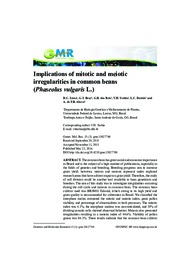Implications of mitotic and meiotic irregularities in common beans (Phaseolus vulgaris L.).
Implications of mitotic and meiotic irregularities in common beans (Phaseolus vulgaris L.).
Author(s): LIMA, D. C.; BRAZ, G. T.; REIS, G. B. dos; TECHIO, V. H.; DAVIDE, L. C.; ABREU, A. de F. B.
Summary: The common bean has great social and economic importance in Brazil and is the subject of a high number of publications, especially in the fields of genetics and breeding. Breeding programs aim to increase grain yield; however, mitosis and meiosis represent under explored research areas that have a direct impact on grain yield. Therefore, the study of cell division could be another tool available to bean geneticists and breeders. The aim of this study was to investigate irregularities occurring during the cell cycle and meiosis in common bean. The common bean cultivar used was BRSMG Talismã, which owing to its high yield and grain quality is recommended for cultivation in Brazil. We classified the interphase nuclei, estimated the mitotic and meiotic index, grain pollen viability, and percentage of abnormalities in both processes. The mitotic index was 4.1%, the interphase nucleus was non-reticulated, and 19% of dividing somatic cells showed abnormal behavior. Meiosis also presented irregularities resulting in a meiotic index of 44.6%. Viability of pollen grains was 94.3%. These results indicate that the common bean cultivar BRSMG Talismã possesses repair mechanisms that compensate for changes by producing a large number of pollen grains. Another important strategy adopted by bean plants to ensure stability is the elimination of abnormal cells by apoptosis. As the common bean cultivar BRSMG Talismã is recommended for cultivation because of its good agronomic performance, it can be concluded that mitotic and meiotic irregularities have no negative influence on its grain quality and yield.
Publication year: 2016
Types of publication: Journal article
Unit: Embrapa Rice & Beans
Keywords: Beans, Feijão, Meiosis, Melhoramento Genético Vegetal, Mitosis, Phaseolus Vulgaris, Plant breeding, Pollen, Pólen
Observation
Some of Embrapa's publications are published as ePub files. To read them, use or download one of the following free software options to your computer or mobile device. Android: Google Play Books; IOS: iBooks; Windows and Linux: Calibre.
Access other publications
Access the Agricultural Research Database (BDPA) to consult Embrapa's full library collection and records.
Visit Embrapa Bookstore to purchase books and other publications sold by Embrapa.

